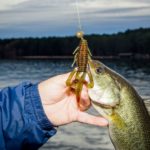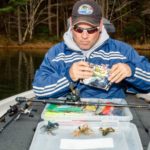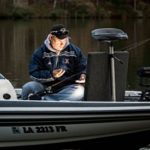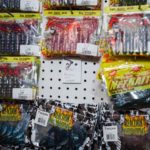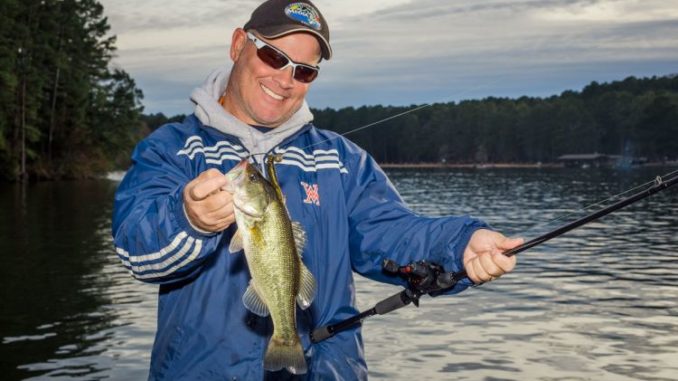
The old debate about effective colors still rages in the bass-fishing community, but this angler said there’s a way to cut through the arguing and make informed decisions.
Several years ago, I was standing at the counter of a tackle shop shooting the bull when a customer dropped several crankbaits next to the cash register.
“You don’t need all those colors,” I told him, as the manager began ringing him up.
I reached into the pile and pulled out a chartreuse crankbait with a blue back.
“This one’s all you need right here,” I advised.
“Will you shut up?” the manager exclaimed.
That drove home the point I had always heard: Colors are for fishermen not fish.
The truth is that there is not a crankbait, spinnerbait, jig, worm or topwater color that won’t catch a fish. Every single one of them — at one time or another — will put bass in the boat.
With so many different colors available, though, how is one supposed to confidently stock his tackle box?
It doesn’t take much looking around in a tackle shop to see that certain colors sell better than others. All you’ve got to do is see which pegs are empty.
Are the missing colors so much better than all the rest that they are constantly having to be restocked?
“That depends,” West Monroe tournament angler Kenny Covington said. “Take my buddy for instance: He throws only one color of square-bill crankbait — Diamond Dust. It’s a color on the Academy H2O series baits that flat-out works, no matter the water color.
“If you ever go into your local store and the peg is empty, that’s probably because he just walked out the door with all the ones they had left.”
And that’s usually how runs on certain colors takes place: An angler whacks the bass on one particular color and decides he needs to stock up on that color so he is never caught without.
“Anglers are funny, though,” Covington said, while we worked watermelon-colored soft plastics on the bottom of Lake Claiborne. “They’re always looking for a shortcut. Say we were catching them on spinnerbaits today. What’s the first question you think somebody would ask us back at the dock?
“No doubt they’d ask what color we were throwing.”
While many fisherman fantasize about finding a magic color, Covington thinks about bait color a little differently. In fact, he ranks it way down on the list of variables he would ask about if he knew a buddy had smashed them.
“Color is important, but not in the way people think,” he said. “I happen to think it’s the most overrated aspect of bass fishing; however, I have 19 million colors in my boat, so I’m a walking contradiction.”
Rather than ask about spinnerbait color, Covington thinks it’s more important to ask about blades and retrieve.
“Heck, everybody up here throws a Colorado/willow, chartreuse-and-white spinnerbait, so it might be a moot point, but knowing what kind of blades somebody is throwing allows you to figure out if the fish are deep, shallow, lethargic or aggressive,” Covington explained. “Then you can take that information and suit it to your own sensibilities.”
So while color might not be the primary reason he selects a particular bait, he does manage his color choices in a way he believes will help catch fish no matter what body of water he’s on.
His experience is that certain colors tend to do better on some lakes than others.
“Take Claiborne,” Covington said. “My dad used to tell me all the time that this was a chartreuse lake. Even today I can catch them up here on a fire tiger spinnerbait, no matter the water color.
“On Caney, candy bug and green pumpkin are great colors — at D’Arbonne, the best jig color is Texas craw.”
That’s one reason certain colors disappear from counters before others, leaving only empty pegs when you go to buy your own.
The fact is that whether it’s based on bass tournaments or past experience, anglers tend to gravitate to different bodies of water at certain times of the year.
When those bodies of water are next on the schedule, anglers flock to tackle shops to stock up on those tried-and-true colors.
“Take our waters around here,” Covington said. “Going to the Ouachita River? Black neon is a good starting point. At D’Arbonne it’s Texas craw jigs and watermelon/red plastics, but it can be a great plum lake during the summer.
“Claiborne? Watermelon/red with chartreuse dye, day in and day out. And you better be taking candy bug and green pumpkin to Caney.”
Why do some colors work better at some lakes than they do at others? Covington believes it has a lot to do with the predominate cover and bottom composition.
Let’s look at crawfish, for example. If you told somebody you were catching bass on a crawfish-colored crankbait, it wouldn’t mean a thing, considering there are hundreds of crawfish-colored crankbaits on the market.
In fact, one crankbait company sells so many crawfish colors it would be hard to list them all here: brown crawfish/chartreuse, brown crawfish/orange belly, spring craw/chartreuse belly, spring craw/dark brown, spring craw/yellow, tequila craw, green with brown crawdad — the list goes on and on.
“And every one of them will catch bass,” Covington said. “So you need to base your crawfish color choice on the lake. Take the Ouachita River, for example: The crawfish I’ve seen hanging on the sides of cypress trees in the backwaters have all been dark black and red. No wonder black neon works there.
“Caney Lake has a sandy bottom, so the crawfish tend to be lighter colored down there. That’s probably why you can catch them so well there on green pumpkin.”
Even if he’s not fishing a crawfish-colored bait, Covington typically tries to match a bait color to the color of the bottom. If it’s a dark, muddy bottom, he goes with dark baits. If it’s a light, sandy bottom he goes with lighter baits.
Beyond bottom composition, Covington believes baitfish and crawfish tend to take on the color of the cover in which they hide.
“Take a lake like D’Arbonne that has cypress trees and grass,” Covington said. “You may pull up to the trees, and see black and red crawfish, so you’d throw a black neon jig. Then that bite turns off, so you go to the grass beds and notice all the bream have a green tint to them, so you pick up a watermelon soft jerkbait and keep catching fish.”
And determining what color to use has more to do with an angler’s power of observation on the water than seeing which pegs are empty at the tackle store.
A good starting point when heading to a lake would be to determine what base colors you should fish based on the bottom and cover. Those colors will work, but perhaps another color or a subtle change in the base color you selected might get you more bites.
“If it’s a lake you’ve never fished before, you should ask the tackle shops, too,” Covington said. “They’ll tell you what color they sell the most of, and that’s could be a good starting point.
“Then hit the water with those colors and start fishing, and let the fish tell you what color they want.”
As you fish, pay attention to the bottom and bait you see. Maybe the shad have a little hint of yellow on their backs or maybe a blue hue to them. Maybe the crawfish a bass spits up in your livewell is brown with blueish pincers.
All these are signs you can use to more accurately match the hatch.
For soft plastics, it might be something as subtle as changing from a base color with red flake to the same base color with green flake. This is how such famous colors as plum apple and june bug were born.
Or maybe you go from a solid-colored worm like tequila sunrise to tequila green.
“I’m sure that’s how that hot new South Africa special color came about,” Covington said. “Somebody was fishing black neon and thought it would work better if they added a little silver flake to it.
“Take my little Biffle Bug, for example: I was throwing it up here at Claiborne not too long ago, and I had the tips dyed chartreuse — couldn’t get bit. I tried a little red dye on the tips, and the fish started biting it. But the base color was still watermelon.”
So how does one know when it’s time to change bait colors? Some have argued that you’ll know you have the right color if fish are choking on your bait. With crankbaits, that means they have the bait way down in their throats. For plastics or jigs, it might mean they’re hitting it harder and holding on longer.
These anglers would argue you should change crankbait colors if you’re hooking a lot of fish on the edges of the mouths or have a bunch of bass just pecking at your worm or jig.
“I don’t know that I agree with that theory,” Covington said. “If fish are aggressive, I think they’re going to choke on it no matter what color you throw.
“Some of the best crankbait anglers in the country are big on it, but I think it might be more of a confidence thing than anything else.”
Covington typically changes bait color if he isn’t getting bit like he thinks he should or if he sees evidence in the water, on his carpet or in his livewell that he’s throwing a color different from what the bass are eating.
“I also change colors if I know everybody and their brother is throwing a certain color,” he said. “If I go to a lake and everybody is throwing watermelon red, I don’t throw it.
“Maybe I’ll throw watermelon candy instead.”
Rather than seeing colors for what they really are, Covington believes bass get more of a sense or silhouette of color.
“Bass live in a dynamic environment,” he said. “Everything’s always moving — especially the stuff they’re trying to eat. I like to compare it to you being in a swimming pool and looking up at the surface. Could you tell what color something was above you? Nope. You’re just going to pick up flashes.
“That’s why clear spinnerbaits and white topwaters are so good on clear days, and dark spinnerbaits and topwaters work so well on dark days.”
Of course, none of this is going to suppress the fun of stocking our tackle boxes with every color imaginable. I mean, how are we going to catch fish if we don’t have the right color?
And when we do get on a hot color, we guard it by buying every pack in the tackle shop.
Color runs are going to happen, and they add to the fun of fishing.
When you tie on a color in which you have the upmost confidence, you’re going to fish that bait better, pitch it in closer and pay more attention to it when it’s in the water.
And if color can inspire confidence, then it’s OK that color matters more to fishermen than it does the fish.

